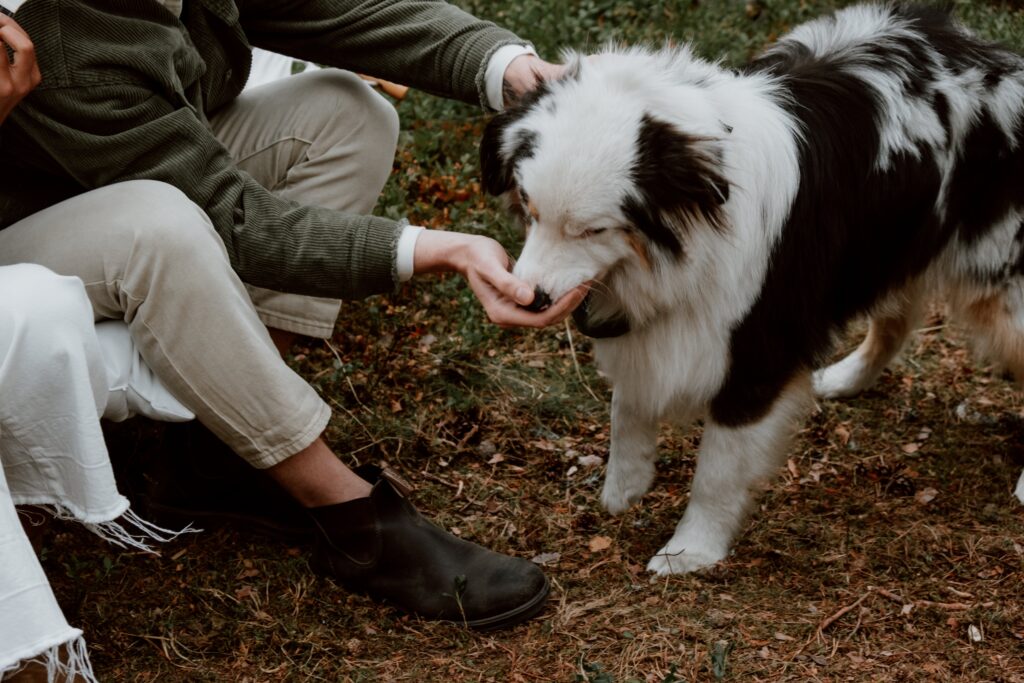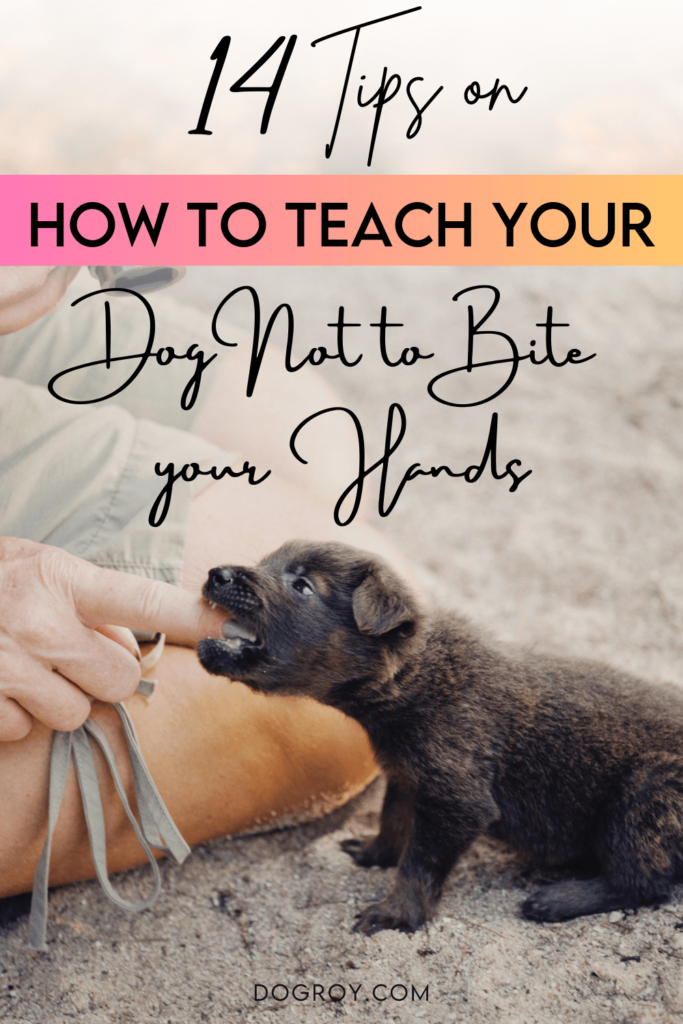Welcoming a new furry friend into your home comes with the joy of companionship and bonding, but it also involves the essential task of teaching them proper behavior.
One common concern many dog owners face is how to teach their dogs not to bite their hands.
Puppy mouthing is a natural behavior, but it’s crucial to guide them towards gentler interactions.
In this guide, we’ll delve into 14 gentle tips on how to teach your dog not to bite your hands, ensuring a harmonious interaction between you and your furry friend.
Table of Contents
Gentle Lessons: 14 Tips on How to Teach Your Dog Not to Bite Your Hands

1] Start Early
Initiating training during your dog’s early stages is a proactive approach to instilling good habits.
Puppies, much like sponges, are highly receptive to learning.
By establishing clear boundaries and teaching bite inhibition early on, you lay the foundation for a relationship free from unwanted biting as your dog matures.
This early training not only shapes their behavior but also contributes to a harmonious bond between you and your canine companion.
2] Use Positive Reinforcement
Positive reinforcement serves as a powerful and positive tool in shaping your dog’s behavior.
When your dog exhibits gentle behavior and refrains from biting, it’s crucial to offer immediate praise, treats, or affection.
This reinforcement not only communicates the desirability of gentle conduct but also creates a strong association between good behavior and positive rewards, encouraging your dog to repeat these behaviors.
Tip: “Create a strong association between good behavior and positive rewards to reinforce gentle manners.”
3] Provide Chew Toys
Offering a variety of chew toys is an effective strategy for redirecting your dog’s natural biting instincts.
Encouraging them to chew on toys instead of your hands not only prevents unwanted biting but also fosters appropriate chewing habits.
4] Teach Bite Inhibition
Teaching bite inhibition involves employing feedback mechanisms to help your dog understand the appropriate force of their bite.
When your dog bites too hard, emitting a yelp or withdrawing attention encourages them to control the pressure of their bite.
This skill is invaluable for maintaining a soft-mouthed approach during play and interactions, preventing accidental injuries as your dog grows.
5] Avoid Rough Play
Establishing clear boundaries during playtime is essential for curbing biting behavior.
Avoid engaging in rough play that might inadvertently encourage biting.
If your dog becomes overly excited and starts nipping, calmly end the play session.
This sends a clear signal that biting leads to the cessation of enjoyable activities, helping your dog understand the limits of acceptable behavior.
Tip: “Signal the end of play if biting occurs, reinforcing that biting leads to the cessation of enjoyable activities.”
6] Socialization
Allowing your dog to interact with other dogs is a crucial aspect of their socialization.
These interactions teach bite inhibition and appropriate play behavior within a canine context.
Positive experiences with other dogs contribute to a well-rounded understanding of acceptable biting limits, helping your dog navigate social situations with grace.
7] Use Bitter Tasting Spray
Aversion training, such as applying a bitter tasting spray on your hands, can be a valuable tool in discouraging biting behavior.
Dogs typically dislike the taste, and this aversion can act as a deterrent.
It’s important to ensure that the spray is safe for pets, and consulting your veterinarian for recommendations ensures that you choose a product suitable for your dog’s well-being.
8] Be Consistent
Consistency is a cornerstone of effective dog training.
Being consistent in your approach to reinforcing a bite-free habit is crucial.
Set clear expectations for your dog’s behavior, and reward compliance with positive reinforcement consistently.
Consistency establishes a predictable environment, making it easier for your dog to understand and adhere to behavioral expectations.
In the rhythm of consistency, biting fades away, leaving behind the melody of gentle interactions.
9] Provide Mental Stimulation
Boredom can be a trigger for biting behavior.
Providing mental stimulation through puzzle toys, interactive games, or regular training sessions is an effective strategy.
A mentally stimulated dog is less likely to resort to hand biting out of boredom, and engaging activities contribute to their overall mental well-being.
10] Enroll in Obedience Classes
Considering enrollment in obedience classes provides professional guidance for addressing biting issues.
Certified trainers offer structured learning environments and hands-on guidance, tailoring their advice to your dog’s specific needs.
Obedience classes are an opportunity for both you and your dog to learn and practice essential skills, enhancing the effectiveness of your training efforts.
11] Use a Distraction
When you observe signs that your dog is gearing up to bite, having a distraction readily available is a proactive strategy.
Keep a toy within reach to redirect their attention from your hands to an appropriate object.
This redirection helps shift the focus away from undesirable biting behavior, reinforcing the notion that toys are the preferred items for chewing.
Tip: “Have a toy readily available to redirect their focus from hands to an appropriate object.”
12] Understand Body Language
Familiarizing yourself with your dog’s body language is a proactive way to anticipate potential biting cues.
Understanding signals such as over-excitement or tense postures allows you to intervene before biting occurs.
Proactive intervention is key to redirecting behavior effectively and maintaining a positive and safe environment.
13] Consult a Veterinarian
If biting behavior persists despite your training efforts, consulting a veterinarian is a prudent step.
Biting can sometimes be a sign of underlying health issues, and ruling out medical causes ensures a holistic approach to addressing the behavior.
Your veterinarian can conduct a thorough examination and provide guidance on potential health-related contributors to your dog’s biting behavior.
• Consult a vet if biting behavior persists despite training • Biting may signal underlying health issues • Ruling out medical causes ensures a holistic approach • Vet can conduct an examination and provide guidance on health-related contributors
14] Be Patient
Teaching your dog not to bite is a gradual process that requires patience and consistency.
Celebrate small victories along the way, acknowledging progress and positive changes in behavior.
Patience is key, and maintaining a positive and encouraging approach fosters a strong and trusting relationship with your furry friend.
How to Teach Your Dog Not to Bite Your Hands: FAQs
Can all dogs be trained not to bite hands?
Yes, with proper training and consistent efforts, all dogs can be taught not to bite hands. However, the duration of training may vary based on the dog’s age, temperament, and previous experiences.
What if my dog only bites during play?
If your dog only bites during play, establish clear boundaries and redirect their attention to toys. Use positive reinforcement to reward gentle play behavior and discourage rough play.
Is it normal for puppies to bite hands?
Yes, puppy biting is a normal behavior. However, it’s essential to redirect this behavior through training to prevent it from becoming a habit as the puppy grows.
Can using bitter spray harm my dog?
Bitter sprays designed for pets are generally safe when used as directed. However, consult with your veterinarian to ensure the product is suitable for your dog.

Conclusion:
As you embark on the journey of teaching your dog not to bite your hands, patience and consistency will be your greatest allies.
By implementing the 14 tips outlined in this guide – (How to Teach Your Dog Not to Bite Your Hands), you’re laying the groundwork for a well-behaved and respectful pet.
Remember, training takes time, so celebrate the small victories, and be persistent in guiding your furry friend towards more appropriate ways of interacting.
With your dedication and these valuable insights, you’ll foster a harmonious and bite-free companionship with your beloved dog.





